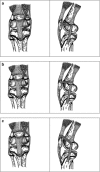Patellar Instability in the Skeletally Immature
- PMID: 29682681
- PMCID: PMC5970107
- DOI: 10.1007/s12178-018-9472-5
Patellar Instability in the Skeletally Immature
Abstract
Purpose of review: This review will focus on the evaluation and management of patellar instability in the developing patient.
Recent findings: A large number of surgical techniques have been described to prevent recurrent patellofemoral instability in the pediatric population, including both proximal and distal realignment procedures. The wide variety of treatment options highlights the lack of agreement as to the best surgical approach. However, when a comprehensive exam and workup are paired with a surgical plan to address each of the identified abnormalities, outcomes are predictably good. Patellar instability is a common knee disorder in the skeletally immature patient that presents a unique set of challenges. Rates of re-dislocation in pediatric and adolescent patients are higher than in their adult counterparts. Careful consideration of the physeal and apophyseal anatomy is essential in these patients. While the majority of primary patellar instability events can be treated conservatively, multiple events often require surgical intervention.
Keywords: Growth plate; Guided growth; MPFL; Modified Grammont; Pediatric patellar instability.
Conflict of interest statement
Conflict of Interest
All authors declare that they have no conflict of interest.
Human and Animal Rights and Informed Consent
This article does not contain any studies with human or animal subjects performed by any of the authors.
Figures



References
-
- Hennrikus W, Pylawka T. Patellofemoral instability in skeletally immature athletes. J Bone Joint Surg Am. 2013;95(2):176–183. - PubMed
-
- Weeks KD, 3rd, Fabricant PD, Ladenhauf HN, Green DW. Surgical options for patellar stabilization in the skeletally immature patient. Sports Med Arthrosc. 2012;20(3):194–202. - PubMed
-
- • Sanders TL, Pareek A, Hewett TE, Stuart MJ, Dahm DL, Krych AJ. High rate of recurrent patellar dislocation in skeletally immature patients: a long-term population-based study. Knee Surg Sports Traumatol Arthrosc. 2017. Skeletally immature patients had a high rate of recurrent instability , 10% of patients in this long term study developed contralateral dislocation and 20% of patients had arthritis at 20 year follow up. - PubMed
Publication types
LinkOut - more resources
Full Text Sources
Other Literature Sources
Research Materials

